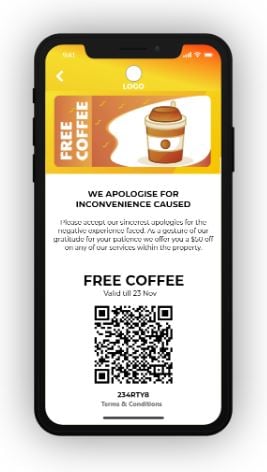“Anything that can go wrong will go wrong.”
That is Murphy’s Law, the most pessimistic law that I have ever heard of. However, it is true that in a process, any faults that can ever appear has a possibility of occurring throughout that process’ entire lifetime.
The same goes for your company. The hard truth is that not everything will go swimmingly for as long as you run your business. Something will crop up, and your customers will be frustrated, or even angry.
Customers are particularly receptive to bad experiences—78% of consumers have scrapped a transaction after a bad service interaction. 32% of all customers will stop doing business with a brand that they love after just one bad experience.
The best way for you to handle that situation would be to appease them with a good customer service recovery strategy.
Why Good Customer Service Recovery is Crucial

When you implement a good customer service recovery strategy, you are assuring the customer that their voice has been heard. You will attend to their needs post-haste, and you will make sure that this never happens again.
Good customer service recovery can net you higher profits—68% of consumers are willing to pay more for good customer service. Good customer service can also entice 78% of consumers to do business with them again after a mistake.
And for 86% of people, good customer service turns them into loyal brand ambassadors. Why is this so?
Because good customer service recovery indicates that you are willing to learn from your mistakes. You are willing to do what it takes to improve your business so that your customers will have a pleasant shopping experience.
If customers are confident that you can resolve their problems in the best way possible, they would come back and patronise your business.
Root Cause Analysis
When a customer comes to you with a complaint, you want to get to the bottom of its cause. That way, you can come up with solutions to prevent future similar incidents. That is where root-cause analysis comes in.
Once you are certain of the root cause, then you can begin coming up with solutions address it.
It wouldn’t do to implement solutions blindly—you’d be wasting precious resources and time that you can use to improve on your core business.
The first step of Root-Cause Analysis would be to figure out your problem statement:
Writing Out a Problem Statement
Write out your problem statement with these seven questions in mind:
- Who is involved in the incident? This can include relevant staff members, the customer, or third-party suppliers.
- Where did the incident occur? Be specific—which area, or which room?
- What happened? Be clear and concise about the exact incident.
- When did this happen? Specify a date and/or time so this incident can be audited.
- Why did this happen? Maybe the batch of medicine was tainted because the machine was faulty. Maybe the sounds from the performance could not reach half the audience because of a broken radio.
- How did you realise the problem? Did the customer complain about worms in their apples?
- How much did the incident impact your customer and your business? What is the opportunity cost and monetary cost associated with this incident?
A problem statement can be:
The batch of chocolate chip muffins baked by Jane Doe, sold in Plaza Singapura on the 1st of April, were discarded because of an ant infestation discovered by a customer. This was because of an anthill growing on the ceiling that went unnoticed, resulting in an unhappy customer and wastage of time and resources.
As you can see, a problem statement need not consist of just one statement. The idea is that the issue at hand needs to be clear to your root-cause analysis team.
Once you derive your problem statement, you can set about realising the root cause of this problem. Here are 3 useful tools that you can use to figure out the root cause of a problem once you are aware of the failure in the system:
1) Ishikawa Diagram
Commonly known as the Fishbone Diagram, the Ishikawa Diagram helps you to narrow down potential root causes of a particular problem.

Often, you would be required to come up with possible root causes that fall into six categories as listed above: Equipment, Process, People, Materials, Environment, and Management.
Using the ant example above, the cause of the anthill’s growth can be due to renovations in a nearby building, causing the ants to make the bakery their new home. That would fall under Environment. It could also be due to the lack of hygiene in the store, which will fall under People.
The Fishbone Diagram forces you and your team to brainstorm and come up with as many possible causes for the incident as possible.
2) 5 Whys

5 Whys is an iterative process where you and your team ask yourself one question: Why?
Starting from your problem statement, ask yourself why. It would usually take you anywhere from 3 to 5 iterations to get to the absolute bottom of it. Let’s go through this process using the bakery example:
- Why is there an ant infestation? Because there was an anthill on the roof.
- Why was there an anthill? Because no-one had noticed it.
- Why had no-one noticed it? Because cleaning the ceiling was not part of the SOP.
After 3 iterations, we have arrived at our answer: the cleaning staff did not notice it because they were never told to check the ceiling for unwanted pests. It was something that you now have to include in your training manual, for the SOP, for your cleaning staff.
In this way, the 5 Whys method makes it easy to see just where your company went wrong, and then you can take steps to correct it.
3) Fault Tree Analysis
This tool works similarly to 5 Whys. It takes an unwanted result, and you work backwards to figure out what could have caused it. This is typically done by using a flowchart:

This helps you to see the problem from multiple perspectives, by considering many possible causes and their causes.
Each secondary cause may be resultant of two or more primary causes. You can even incorporate your 5 Whys reasoning into your Fault Tree.
Corrective and Preventive Action (CAPA)
Now that you are certain of the root cause of your customer’s bad experience, you can get to finding a solution to your customer’s pain. Your solution should also prevent future incidents like this from occurring.
Once you come up with a solution… how do you know that it actually works? How can you be sure of its effectiveness?
In this case, you might want to use a framework called the PDCA, or the Plan-Do-Check-Act cycle.

- Plan: Think of a way to implement your solution into your business processes.
- Do: Actually implement your solution.
- Check: Take note of how your solution has soothed customer worries and whether similar incidents have occurred ever since implementation.
- Check: If similar incidents still occur, then you may want to make some adjustments to your solution, leading you back to your planning process.
This framework is easy to understand, and it helps you ensure that your solution can help your customers—and your business—solve your problem.
Conclusion
Customer service recovery has never been more important in today’s society. Businesses today are competing based on customer experience, less so than on product and price, since that is what customers want.
When something untoward happens to your customer, you need a way to rectify that problem immediately.
But it is difficult to work out a solution if you don’t even know what went wrong in the first place. For that, Vouchermatic can lend you a hand!
With our voucher management system, you can incentivise customers with discounts and coupons to give you their feedback on your business.

This can all be automated without any input from you. Moreover, your vouchers would be sent in real-time, after a trigger, such as after a customer submits a completed form.
Contact us here to see how we can help you get your customer service recovery right today!

